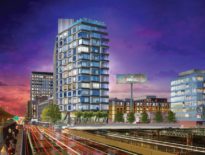
"Pod" style hotels such as the 326-room YOTEL in Boston’s Seaport District provide an option for budget-conscious travelers, with smaller guest rooms, active public spaces and high-energy food and beverage programs.
Driven by a strong and balanced mix of corporate, leisure and convention destination demand, Boston continues to be a top-five performing U.S. hotel market. The city boasts an extremely stable demand mix with commercial, group and leisure sources distributed at just over 30 percent each.
The local hotel industry had a strong end to 2018, and CBRE Americas Hotel Research projects a 4.3 percent supply increase and a 3.3 percent demand increase for 2019. Average daily rates (ADR) are also projected to climb in Greater Boston; rates grew 1.6 percent in 2018 and should appreciate another 1.1 percent in 2019. Greater Boston’s attributes are strong, deep and enduring. The region will continue to maintain its position as a highly desirable lodging investment market.
Increased demand often fuels new construction, and across Greater Boston additional lodging supply is certainly on the horizon. New hotels are currently under construction in virtually all the city’s submarkets, with measured addition to room inventory being realized over the next five years. However, due to the city’s relatively small landmass, high construction costs and rigorous entitlement process, Boston is unlikely to experience any significant oversupply in the foreseeable future.
A Continuing Luxury Boom
While hotels tend to undergo cosmetic updates and improvements on a five– to seven-year cycle, competitive properties tend to do a more comprehensive revamp about every 15 years. Extensive renovations are currently in process within Boston’s existing luxury lodging inventory. This current luxury set, including The Ritz-Carlton, Mandarin Oriental and Four Seasons, will soon be joined by the refreshed Taj Boston, Langham and the much-anticipated Four Seasons at One Dalton. Essentially that equates to over 1,000 freshly renovated rooms within Boston’s luxury hotel stock.

Dave McElroy
While not new, it is notable that – at least in Boston proper – nearly every luxury hotel constructed in recent years has been part of a mixed-use component, specifically residential and retail. Those projects include the Battery Wharf Hotel, InterContinental and W Boston, as well as the Mandarin Oriental and Four Seasons at One Dalton. The rare exceptions may be the Loews Hotels, which was a dramatic adaptive reuse of the police headquarters, and The Liberty, another highly successful adaptive reuse of the Charles Street jail.
‘Pods’ Offer Economic Alternative
On the other end of the chain-scale, we have also seen the growing popularization of a vastly different product type in Boston called “pod” hotels. As market creativity increases and guest segmentation becomes finer and finer, a different type of physical room design has been created to suit those varying needs.

Scott Hutchinson
Born in the late 1970s in Japan, the volume of pod-style guest rooms is growing around Boston. Standard pod hotel rooms typically span from roughly 150 to just under 200 square feet, which is just around half the size of a standard mid- to upper-scale American guest room. Despite the small room bay, these hotels are rich in technology and amenities. Local examples include the 326-room YOTEL in the Seaport District, in addition to two projects currently under construction: the 272-room citizenM Boston – part of The Hub on Causeway development – and the 346-room Moxy Hotel in the Theater District.
This kind of hotel stay is considered an economic alternative for budget-conscious guests within a market that is heavily tilted toward upper-scale and luxury product. Pod hotels tend to emphasize active and energized public spaces, and food and beverage amenities. This encourages a younger, more rate-sensitive segment of guests to spend more time and money in the public spaces than in their rooms.

Geoff Evans
From an investment perspective, pod hotels also make a lot of sense for a land-restricted, historic city like Boston, where high land costs can prohibit development. With this pod model, more hotel rooms can be realized within a smaller footprint.
As new supply has gradually entered the Boston market, dynamic concepting and design have created differentiated lodging products to satisfy each segment of consumer demand, allowing for stable healthy performance. While we expect this kind of creativity to continue within Boston’s prospering hotel market, only time will tell how the market responds to these new developments and trends. We are optimistic that the local lodging market will always adapt and innovate as Boston continues to be a destination for business travelers and tourists.
Dave McElroy is senior vice president, Scott Hutchinson is first vice president and Geoff Evans is an associate in CBRE’s hotel brokerage and investment sales team.




 |
| 

